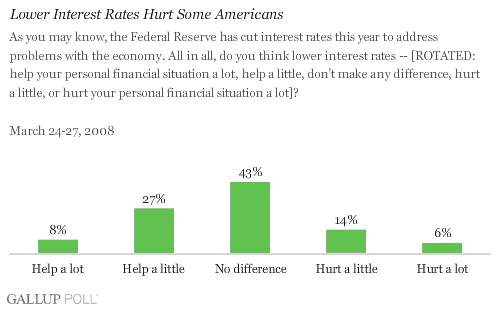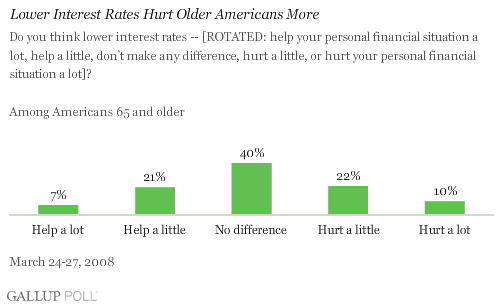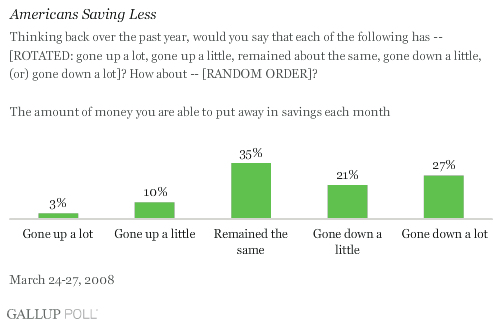PRINCETON, NJ -- Today's lower interest rates are generally seen as positive for consumers, with one in three Americans saying the reduction in rates is helping them financially. Still, one in five consumers overall -- and one in three of those 65 years and older -- say the rates are hurting them, according to a March 24-27 Gallup Poll.

Some Are Hurt As Fed Lowers Rates
In response to the global financial crisis, the Federal Open Market Committee (FOMC) has lowered interest rates by 2 percentage points since January and by 3 points since last summer. Generally speaking, lower interest rates are seen as a positive for the economy in that they tend to lower the cost of borrowing and thereby help consumers and business, while simultaneously promoting economic growth. In this regard, it is not surprising that 35% of Americans report that lower rates have helped improve their personal financial situations a lot (8%) or a little (27%).
At the same time, not all Americans think lower interest rates are helping them. The plurality (43%) say lower rates make no difference to their personal financial well-being. However, 20% say lower interest rates have hurt their financial situations either a lot (6%) or a little (14%). Many of those being hurt are older Americans who have seen the earnings they get on their savings decline substantially during recent months. While 28% of those 65 and older say lower interest rates have helped them financially, 32% say they have actually been hurt as the Fed has lowered rates.
Lower interest rates also tend to have a disproportionately negative effect on lower-income Americans, with 29% of those making less than $35,000 a year saying they have been hurt by lower rates, compared to 23% of those making $35,000 to $74,999, and only 12% of those making $75,000 or more. Lower interest rates are hurting older lower- and middle-income Americans who depend on their interest earnings as a substantial part of their incomes.

Lower Interest Rates Also Reduce Savings
Nearly half of consumers report reducing the amount of money they have put away in savings each month a lot (27%) or a little (21%) over the past year. The current consumer squeeze that has most Americans paying more for essentials such as food and gas is the most obvious explanation for this decline, as many consumers try to maintain their living standards by saving less. At the same time, lower interest rates may be exacerbating the savings problems, because they reduce the incentive for people to save more.

Should the Fed Continue to Lower Rates?
Over the next couple of weeks leading up to the FOMC meeting at the end of the month, there is likely to be considerable debate about whether the Fed should continue to lower interest rates. On the one hand, it will be argued that the financial markets remain fragile and the U.S. economy appears to be in a recession. Many economic observers will join those on Capitol Hill who are looking toward the elections later this year in urging the Fed to lower rates further in hopes of stimulating an economic recovery as soon as possible.
On the other hand, and as was seen in the FOMC meeting minutes released Tuesday, others will talk about the potential inflation danger associated with lower interest rates. They will also note that lower rates have hurt the value of the U.S. dollar. In turn, the lower dollar has translated into higher oil and global commodity prices. As a result, gas and food prices may remain high or go even higher while the U.S. economy slows, making the U.S. recession worse.
Gallup's polling suggests another consideration that should be part of this debate but is often ignored. Many older lower- and middle-income Americans are seeing less and less of a return on their savings and investments. At this stage of their lives, they want to avoid losing their hard-earned savings and, thus, they want to avoid today's chaotic financial markets. At the same time, the interest they can earn in safe investments in their banks or treasuries continues to decline. This squeeze on older Americans deserves to be part of the FOMC interest-rate debate.
Survey Methods
Results for this panel study are based on telephone interviews with 1,005 national adults, aged 18 and older, conducted March 24-27, 2008. Respondents were drawn from Gallup's household panel, which was originally recruited through random selection methods. The final sample is weighted so it is representative of U.S. adults nationwide. For results based on the total sample of national adults, one can say with 95% confidence that the maximum margin of sampling error is ±4 percentage points.
In addition to sampling error, question wording and practical difficulties in conducting surveys can introduce error or bias into the findings of public opinion polls.
